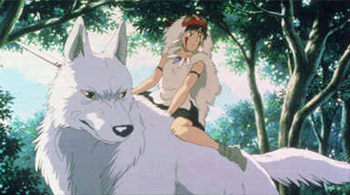![[Metroactive Books]](/books/gifs/books468.gif)
[ Books Index | Silicon Valley | Metroactive Home | Archives ]
Cel High
'The Anime Encyclopedia' gives a genre its due in depth
By Richard von Busack
FLYING SQUIDS, talking robots and Japanese girls in sailor suits are the featured players in Helen McCarthy and Jonathan Clements' The Anime Encyclopedia: A Guide to Japanese Animation Since 1917 (Stone Bridge Press; $24.95). This is the book the world of anime has been waiting for. No other study in the English language has been this thorough--and if such a book did exist, it would have been done by co-author McCarthy, who wrote an indispensable study of Hayao Miyazaki, director of Princess Mononoke and My Neighbor Totoro.
Among the 2,000 listings are everything from Perfect Blue (a nice try of a thriller with a narrative so tangled that the only one sure of where he stood was the guy selling popcorn in the lobby) to the classic treats Barefoot Gen and The Grave of the Fireflies. Speed Racer (a.k.a. "Go Mifune") shows up, of course. And there are various items about the work of the Japanese Disney: Osama Tetzuko, whose intrepid and charming work was adapted for the recent release Metropolis.
The authors approach their subject with as much amusement as authority. Without this encyclopedia, we would probably never know that a character named "Gust Turbulence" was the anti-hero of the anime Agent Aiku. Having finished the blow-by-blow account of the bodice slasher Lunatic Night, McCarthy and Clements conclude, "The authors would like to apologize for making this sound a lot more interesting than it is."
Interviewing the authors by email, I ask, "How in the world did you ever manage to see so many of these animes?"
"I think I did something really awful in a past life," Clements responds.
"We worked at it," McCarthy adds. "And we didn't watch all of them ourselves. As we say in the introduction, others saw a lot of the films in the book, people whose word we trust. Where we state a strong opinion, we have seen the film."
And the worst of them all? "For me, it's The Gigolo," McCarthy responds. "I would rather watch paint dry."
"So many to choose from ... " Clements writes. "Officially, the worst anime ever made is something called Butchigiri, which was so bad that even the animators who worked on it disowned it."
The authors hope that some more attention will be drawn to their favorite animes. "There are many that would repay viewing on a huge screen with a good sound system," McCarthy figures. "Miyazaki's My Neighbor Totoro made me fall in love with Japanese animation."
Clements was first hooked by one particular anime: "Gunbuster, a simple tale of kamikaze schoolgirl rocket pilots, fighting to defend the Earth from alien invaders, who discover that the aliens have the moral high ground and that it is better for the universe if humanity loses. It's a heartrending allegory of the Pacific War.
"And Momotaro's Divine Sea Warriors is the first-ever feature-length anime, a propaganda film made in 1945. It's also a real survivor--anime cels were in such short supply that the animators had to wash each one with acid and reuse it, so the original artwork that made the film was destroyed even as it was made. After the war, the occupation forces thought they had shredded all copies of it, but a print was found hidden in a warehouse in 1983, and rereleased in Japan. If I had my own DVD company, that would be the first title I bought--though I doubt I'd sell more than a dozen copies."
"If there is one thing that attracts me to anime," McCarthy notes, "apart from the visual dynamic, it's the willingness to consider wide-ranging story and character possibilities, covering a wide spectrum, from mass TV fodder to wildly experimental work."
This "mass TV fodder" floods the markets, and sometimes intelligent anime is vandalized by bored voice-over actors. "It's annoying when actors and directors turn in a bad job because they just can't be bothered," Clements writes, "But that kind of lack of professionalism just reflects badly on those concerned."
Clements adds, "The computer-game tie-ins are perfectly honest about what they are, so it's not really possible to get annoyed about them. Such releases pay for the more obscure releases, so I prefer to see them as unwitting patrons of the arts! And thanks to DVD, we do at least stand a better chance of seeing the originals. You can walk into a video store and buy the uncut original anywhere in America. You have a much better chance of seeing good anime today than you ever did in the past."
[ Silicon Valley | Metroactive Home | Archives ]
Copyright © Metro Publishing Inc. Metroactive is affiliated with the Boulevards Network.
For more information about the San Jose/Silicon Valley area, visit sanjose.com.
![]()

Walk on the Wolf Side: San takes a ride on Moro in Hayao Miyazaki's supreme anime, 'Princess Mononoke.'
From the February 7-13, 2002 issue of Metro, Silicon Valley's Weekly Newspaper.